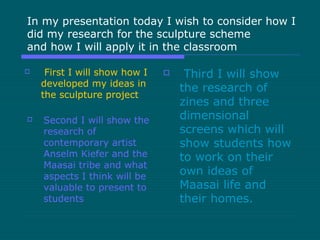
Sculpture s
- 1. In my presentation today I wish to consider how I did my research for the sculpture scheme and how I will apply it in the classroom First I will show how I developed my ideas in the sculpture project Second I will show the research of contemporary artist Anselm Kiefer and the Maasai tribe and what aspects I think will be valuable to present to students Third I will show the research of zines and three dimensional screens which will show students how to work on their own ideas of Maasai life and their homes.
- 2. My starting point was looking at the materials used by the artist Anselm Kiefer. I was interested in how he made books from lead and cardboard to make sculptures that were suggestive of ruin
- 3. I started experimenting with making little paper books and then larger paper books
- 4. I painted one of the books and had the idea of using it as a piece for a story and I painted a cardboard box which I folded out into two screens, painting the inside white and outside black.
- 5. I used one of Kiefer’s forest images and drew from this onto the cardboard using pencils, colouring pencils, pastels and white spirits.
- 6. I added some objects I had collected to the foreground along with one of the paper books and photographed them.
- 7. My experimentation in the sculpture project gave me two types of ideas that the students could use to make three dimensional sculpture about the Maasai tribe and vernacular architecture. Two is that they use their zine as inspiration to make a three dimensional free standing cardboard screen using their own designs and other materials One is that they create their own zine with their partner focusing on questions about the Maasai tribe
- 8. With this in mind, I will present students with sets of questions on the Maasai tribe and Anselm Kiefer. They can then investigate these according to the artworks we look at and the way of life of the Maasai tribe. They can answer them in their own expressive ways through making their zines and cardboard screens. Here are sample questions I will use. Look closely at Kiefer’s artworks. List the range of materials he uses in his art-making. Do the materials surprise you? Why? Are his artworks paintings or sculptures? Describe their surface qualities and the range of colours he uses. What do they remind you of? Imagine you could step into one of his artworks. What sounds would you hear? What would it smell like?
- 9. With the Maasai tribe, I will ask the students to look up first and second hand account information. Here is an example of some questions from a Maasai and American exchange project aimed at recording Maasai oral history. Q Do the Maasai wear shoes? They seem to do a lot of walking. A The Maasai people wear shoes, too. In the past the open shoes were made from the cowhides and they lasted longer. All types or shoes are worn these days but some do not like them though. Children go to school and shoes are part of their uniform. Q. Do they draw pictures to tell stories? A. The Maasai do not draw pictures to tell stories. Q. Since Maa is an unwritten language; I wonder how the Maasai communicate with each other if they do so in ways other than oral storytelling? Or has it been forbidden, or taboo, to even consider such a thing? A. Maasai didn’t have their language written. Most Maasai people did not go to school and it was easy to communicate even without written Maa. Their main way of communication was through oral conversation. They passed on information from village to village through Ilomon. If two elders met on the way, they would both converse and tell information about their family, health and anything new that is happening. If they had some important information that has to be passed to everybody they would call a meeting entumo. This is how information is conveyed.
- 10. Students can now format their questions, answers and thoughts about the Maasai into a zine of their own invention. Here is an example of a zine making workshop with Aaron Rose http://youtu.be/YFud1dKIhek Zines are self published materials with short print runs. Zines can be about anything from your favourite band to what you did on your summer vacation.
- 12. Cardboard screen by Luci Lytle From their zine, students can use this as inspiration to make a screen that uses cardboard and other materials.